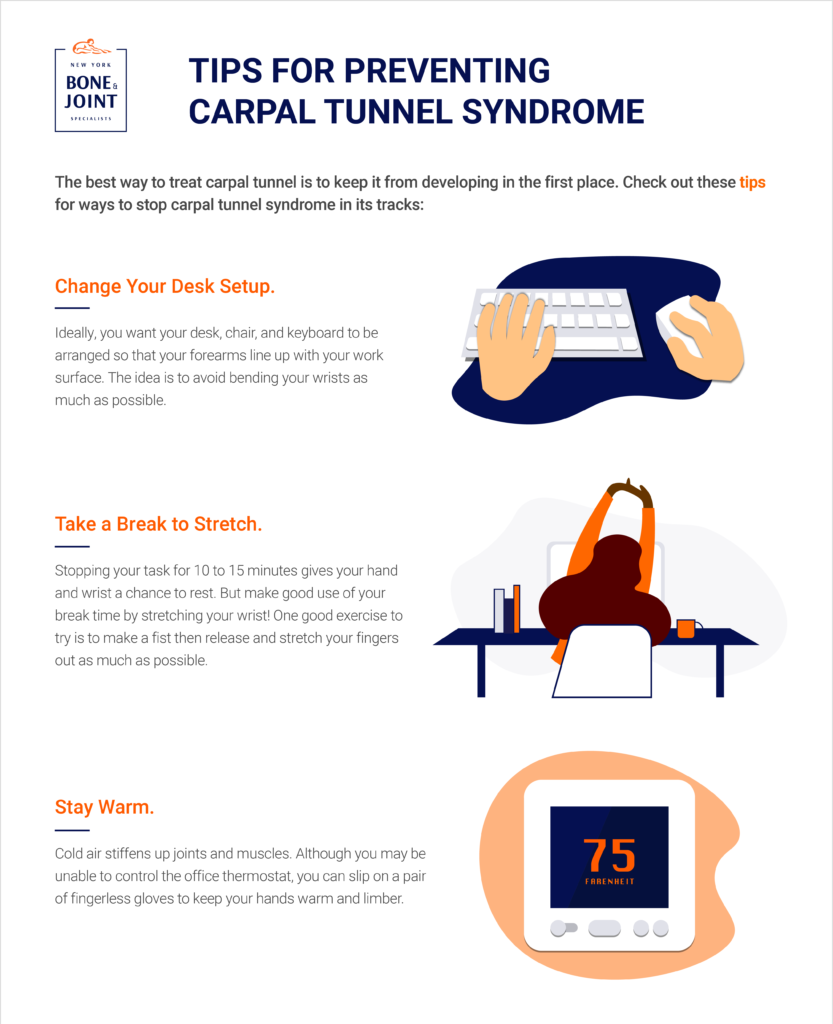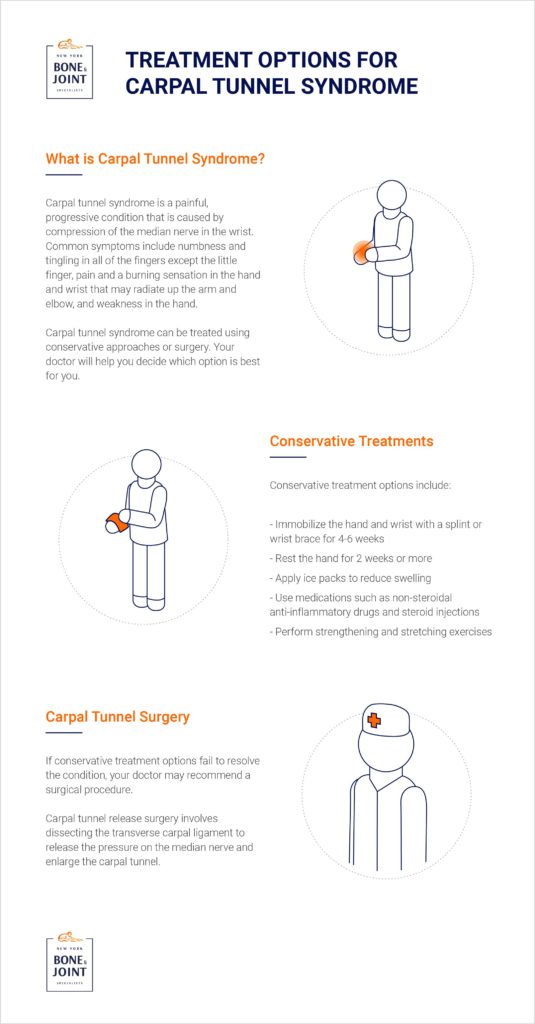Carpal tunnel syndrome is a painful and progressive condition that causes numbness, tingling, and weakness in the hand. If left untreated, it can interfere with sleep, work, and daily life. At New York Bone and Joint, our expert team provides specialized care to diagnose and treat carpal tunnel—helping you feel better, faster.
This common condition usually appears alongside other wrist issues, like a fracture or repetitive strain injury. However, you don’t always need to have suffered a previous issue to experience the syndrome’s symptoms.
Our top-rated hand and wrist doctors are experienced in carpal tunnel syndrome treatment and will work with you to create a plan that alleviates the common symptoms and pain of this progressive problem. Our approach involves exercises, physical therapy, and, if necessary, surgical intervention.
Let’s find out more about carpal tunnel syndrome and how we can help you recover.
What are the symptoms of carpal tunnel syndrome?
Symptoms often appear slowly and progressively worsen the longer the condition is left untreated.
You may experience:
- Tingling & Numbness: It’s common to feel a tingling sensation in the fingers, quite like a minor electric shock. This feeling can make it difficult to sleep at night or perform daily activities, like holding items.
- Weakness: Carpal tunnel syndrome causes weakness in the hand. You may find it difficult to lift or hold items, or that you drop items you are holding unintentionally.
What causes carpal tunnel syndrome?
The carpal tunnel makes up part of the anatomy of the human wrist. It’s an area of the wrist where the median nerve passes through. The median nerve is a major nerve in the arm and connects the brain with the hand, allowing for movement and feeling.
When the carpal tunnel tightens, it places additional pressure on the nerve, restricting movement in the hand and affecting feeling up and down the forearm.
Often, this tightening is caused by other conditions, such as a poorly healed fracture or a repetitive strain injury.
In addition to injury-related causes, certain life stages and medical conditions can increase your risk. For example:
Carpal tunnel syndrome in pregnancy
Tightening of the carpal tunnel is a very common experience for women during pregnancy. Fluid retention and hormonal shifts, both common during pregnancy, can affect the flexibility of the wrist’s ligaments and place added strain on the nerves of the forearm.
Carpal tunnel syndrome in diabetes
A tightening carpal tunnel is also commonly associated with diabetes. High blood sugar has been known to affect the looseness of the body’s tendons and ligaments. In the wrist, this tightening places pressure on the median nerve needed for a carpal tunnel syndrome diagnosis.

How is carpal tunnel syndrome diagnosed?
Our carpal tunnel syndrome specialists use a variety of tests to diagnose the causes of your symptoms.
Your first appointment will include a discussion about your symptoms, lifestyle, and medical history. We might also perform a physical examination or other tests to determine whether you have carpal tunnel syndrome.
Here’s what to expect:
- Physical examination: One of our top-rated hand and wrist doctors will begin by testing the feeling in your hand and fingers. We’ll try some movement exercises and assess your grip strength and reflexes.
- X-ray: You may need to have an X-ray to rule out other symptoms. X-rays aren’t used to diagnose carpal tunnel syndrome, but they can help us see if you have another condition, like a fracture or arthritis.
- Ultrasound: An ultrasound can help us see the nerves in close detail. We’ll be able to see any compression or tightness in the carpal tunnel this way.
- Electromyography (EMG): This test helps us evaluate how your nerves and muscles are functioning. It involves applying small electrical impulses to your wrist and forearm to check for nerve damage.
- Nerve conduction study: Much like an EMG, a nerve conduction study helps us identify how signals travel along the nerves and whether there is any loss of electrical activity or slowing down within the carpal tunnel.
Two conditions that are often misdiagnosed as carpal tunnel syndrome are tendonitis and rheumatoid arthritis. Both these ailments have similar symptoms to carpal tunnel syndrome, but have different underlying causes and long-term treatment options.
When to see a doctor for carpal tunnel syndrome
You should see a specialist for carpal tunnel syndrome if you’ve been experiencing symptoms for a few weeks. The condition is progressive and will worsen the longer you go without treatment.
“Carpal tunnel syndrome affects millions of people, but early intervention can prevent permanent nerve damage and restore normal hand function. We offer a range of treatments, from conservative splinting and therapy to minimally invasive surgical release when needed.” – Dr. Leon Popovitz, MD, Co-Founder of New York Bone & Joint.
How is carpal tunnel syndrome treated?
Specific treatment plans will depend on your personal circumstances, such as your age, general health, and what you do for work.
Our carpal tunnel syndrome specialists work with you to develop a course of treatment that fits your needs and lifestyle. Here is what you can generally expect:
Non-Surgical Treatment
Carpal tunnel syndrome may be treated using conservative approaches or surgery. The conservative treatments include:
- Treating underlying medical conditions, like a repetitive strain injury.
- Immobilization of the hand and wrist with a splint or wrist brace for 4-6 weeks
- Rest the hand for 2 weeks or more
- Ice packs to avoid swelling
- Avoid activities that tend to worsen the symptoms
- Medications such as nonsteroidal anti-inflammatory drugs and steroid injections
- Strengthening and stretching exercises once symptoms diminish

Surgery for Carpal Tunnel Syndrome
If conservative treatment options fail to resolve the condition your surgeon may recommend surgical procedure.
Carpal tunnel release surgery
Carpal tunnel syndrome can be treated with surgery to release pressure on the median nerve. Traditional surgery uses a 2-inch incision, while endoscopic surgery uses one or two half-inch incisions and an endoscope. Your surgeon will choose the best option for you.
Post-operative care
Your surgeon may suggest you to practice certain post-operative procedures for better recovery and to avoid further complications.
- Elevate the hand above heart level to reduce swelling.
- A splint may be worn
- Ice packs to the surgical area to reduce swelling.
- Keep the surgical incision clean and dry. Cover the area with plastic wrap when bathing or showering.
- Physical therapy may be ordered to restore wrist strength.
- Eating a healthy diet and not smoking will promote healing
Risks and complications
The majority of patients suffer no complications following carpal tunnel release surgery. However, some patients may experience pain, infections, scarring, and nerve damage, resulting in weakness, paralysis, loss of sensation, and stiffness in the hand and wrist area.
How to prevent carpal tunnel syndrome
There is no surefire way to prevent carpal tunnel syndrome. However, you can take steps to reduce the pressure on your hands and wrists and lessen the risk of developing the condition.
Let’s take a look:
- Keep a good posture when working at a desk. Slouching can cause the shoulders to roll forward and shorten the muscles, placing additional strain on the nerves.
- Take frequent breaks
- Change your mouse and keyboard to a more ergonomic and comfortable design.
- Keep your hands warm in cold environments to relieve muscle tension.

Carpal tunnel syndrome exercises
Some exercises help to lengthen the carpal tunnel and relieve symptoms of nerve pressure. These exercises are often prescribed alongside other conservative treatments and are safe to perform at home with guidance from your specialist.
Wrist Flexes and Extensions: Extend your arm in front of you with your palm facing down. Gently bend your wrist downward until you feel a mild stretch on the top of your wrist and forearm. Hold for 15-30 seconds. Then, flip your palm up and gently pull your hand toward you with your other hand until you feel a stretch in your wrist and forearm. Hold for 15-30 seconds. Repeat 3-5 times on each hand.
Wrist Rotation: Hold your arms out in front of you and make gentle circles with your wrists, rotating them clockwise for 10 rotations, then counterclockwise for 10 rotations. Keep the movements slow and controlled. This helps maintain wrist mobility and reduces stiffness that can contribute to carpal tunnel symptoms.
Finger and Thumb Stretches: Make a gentle fist with your thumb on the outside, then slowly open your hand and spread your fingers wide. Hold for 5-10 seconds and repeat 5 times. For thumb stretches, gently pull your thumb back toward your wrist with your other hand until you feel a mild stretch. Hold for 15-30 seconds and repeat 3 times on each hand.
Wrist Curls: Rest your forearm on a table with your hand hanging over the edge, palm facing up. Holding a lightweight (1-2 pounds) or resistance band, slowly curl your wrist upward, then lower it below the table level. Perform 10-15 repetitions, then flip your hand over (palm down) and repeat the movement in the opposite direction. This strengthens the muscles that support proper wrist alignment.
Important Exercise Guidelines:
- Stop any exercise that increases numbness, tingling, or pain
- Perform exercises 2-3 times daily for best results
- Start slowly and gradually increase repetitions as tolerated
- Always warm up with gentle wrist rotations before stretching
Why are we among NYC’s best orthopedic hand and wrist doctors?
For decades, New Yorkers have trusted our renowned carpal tunnel syndrome doctors and surgeons. We are proud to be among the best for several reasons:
- Joint Health First: We prioritize the health and healing of your joints, which are crucial for an active and fulfilling life.
- Comprehensive & Compassionate Care: Our world-class specialists offer expert and compassionate guidance for a wide range of carpal tunnel syndrome conditions, from initial diagnosis to full rehabilitation.
- Effective Non-Surgical Solutions: Remarkably, over 90% of carpal tunnel syndrome issues are successfully resolved through our orthopedic treatments, often without the need for surgery.
- Dedicated to Your Full Recovery: We are committed to achieving complete patient recovery, utilizing conservative approaches and expert surgical intervention only when absolutely necessary.
Our best-rated orthopedic carpal tunnel syndrome specialists in NYC
At New York Bone & Joint Specialists, our philosophy centers on preserving your body’s natural structures. This approach allows 90% of our patients to recover without surgery, fostering long-term hand and wrist health and providing peace of mind. We are dedicated to delivering exceptional care, ensuring the lasting health and function of your hands and wrists.
Make an appointment today
Ready to take the first step toward relief? Schedule an appointment with New York Bone & Joint Specialists and start your personalized recovery plan today.
Carpal tunnel syndrome: FAQs
What is the recovery time for carpal tunnel syndrome surgery?
Recovery from carpal tunnel surgery typically takes 6-12 weeks for basic activities and 3-6 months for full strength and function. Most patients can return to light office work within 1-2 weeks, while those with physically demanding jobs may need 6-8 weeks off.
Complete healing of the surgical site occurs around 10-12 weeks, but grip strength and endurance continue to improve for several months.
What specialists treats Carpal Tunnel Syndrome?
Carpal tunnel syndrome is best treated by orthopedic hand surgeons, plastic surgeons specializing in hand surgery, or neurologists who specialize in nerve disorders.
At New York Bone & Joint Specialists, our board-certified orthopedic surgeons have specialized fellowship training in hand and wrist conditions, ensuring you receive expert care from diagnosis through treatment and recovery.
How to find a carpal tunnel syndrome specialist near me?
Look for board-certified orthopedic surgeons or plastic surgeons with fellowship training in hand surgery. Check their credentials through medical boards, read patient reviews, and verify they have experience specifically with carpal tunnel treatment.
At New York Bone & Joint Specialists, we have multiple convenient NYC locations staffed by specialists who focus exclusively on hand and wrist conditions.
Can carpal tunnel syndrome be treated without surgery?
Yes, early-stage carpal tunnel syndrome often responds well to conservative treatments including wrist splinting (especially at night), activity modification, ergonomic improvements, physical therapy exercises, anti-inflammatory medications, and corticosteroid injections.
Over 90% of our patients experience significant improvement with non-surgical approaches when caught early. Surgery is typically reserved for severe cases or when conservative treatments haven’t provided adequate relief.
How long should I wear a wrist splint for carpal tunnel syndrome?
Most patients benefit from wearing wrist splints primarily at night for 6-12 weeks, as symptoms are often worse in the morning due to hand positioning during sleep.
Some may also need to wear splints during activities that trigger symptoms. Your specialist will provide specific guidance based on your symptom severity and response to treatment. Consistent use during the initial treatment period is crucial for success.



